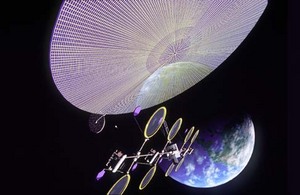Not many people I know think space solar is a low-cost, scalable solution.
 Certainly it is worth pursuing any genuine low-carbon baseload power source if it can be practical and scalable — and affordable, which I would put at $0.15 a kilowatt hour or less for. The problem with space solar is that, like hydrogen fuel-cell cars, there is little chance it could be affordable until it is massively scaled up — and no guarantee that it would be practical and affordable even then. That’s one reason major utilities have been unwilling to take the risk on it.
Certainly it is worth pursuing any genuine low-carbon baseload power source if it can be practical and scalable — and affordable, which I would put at $0.15 a kilowatt hour or less for. The problem with space solar is that, like hydrogen fuel-cell cars, there is little chance it could be affordable until it is massively scaled up — and no guarantee that it would be practical and affordable even then. That’s one reason major utilities have been unwilling to take the risk on it.
Until now.
Apparently at least one serious utility that has invested in “wind, geothermal, biomass, wave and tidal, and at least a half dozen types of solar thermal and photovoltaic power” is looking in to it. Jonathan Marshall, Chief, External Communications, Pacific Gas and Electric Co., sends me a link to his posting on NEXT100.com, “a blog supported by PG&E that explores the intersection of the clean energy business and the environment”:
PG&E is seeking approval from state regulators for a power purchase agreement with Solaren Corp., a Southern California company that has contracted to deliver 200 megawatts of clean, renewable power over a 15 year period.
Solaren says it plans to generate the power using solar panels in earth orbit, then convert it to radio frequency energy for transmission to a receiving station in Fresno County. From there, the energy will be converted to electricity and fed into PG&E’s power grid. (See interview with Solaren CEO Gary Spirnak.)
Why would anyone choose so challenging a locale to generate electricity? For one, the solar energy available in space is eight-to-ten times greater than on earth. There’s no atmospheric or cloud interference, no loss of sun at night, and no seasons. That means space solar can be a baseload resource, not an intermittent source of power. In addition, real estate in space is still free (if hard to reach). Solaren needs to acquire land only for an energy receiving station. It can locate the station near existing transmission lines, greatly reducing delays that face some renewable power projects sited far from existing facilities.
Yeah, well good luck PG&E!
Wikipedia has a good entry on SBSP here. Scale and cost are probably the biggest problems. You probably need more than a factor of 10 more drop in launch costs. The space community has been promising such a drop was just around the corner for decades, now.
It seems all but inconceivable that you could get the cost to drop that sharply without economies of scale and a learning curve driven by a massive number of regular launches. But who is going to pay for all those incredibly expensive space-based solar systems before the cost drops?
This is a classic chicken and egg problem, compounded by the fact that there is no guarantee you will actually get the cost drops even with large-scale deployment, so all of your money is at grave risk.
The risk is even greater because land-based solar baseload (or load following or dispatchable solar) — aka Concentrated solar thermal power — is practical and scalable now, and certain to be much cheaper. And land-based PV is poised to drop in cost sharply, and will ultimately have access to tremendous land-based storage through plug-in hybrid and electric cars.
Then we have the life-cycle emissions issue. It takes a massive amount of rocket fuel to put stuff in orbit.
Solaren CEO Gary Spirnak glosses over this entire issue in his interview with Marshall on the web (here):
Q: Is the renewable energy generated from this project completely carbon-free?
A: Yes. Solaren’s SSP energy conversion process is completely carbon-free.
Q: How will this project impact the environment?
A: The construction and operations of Solaren’s SSP plant will have minimal impacts to the environment. The construction of the SSP ground receive station will have no more environmental impact than the construction of a similarly sized terrestrial photovoltaic (PV) solar power plant. Space launch vehicles will place the SSP satellites into their proper orbit. These space launch vehicles primarily use natural fuels (H2, O2) and have an emissions profile similar to a fuel cell. When in operation, the Solaren SSP plant has a zero carbon, mercury or sulfur footprint. In addition, the high efficiency conversion of RF energy to electricity at the SSP Ground Receive Station does not require water for thermal cooling or power generation, unlike other sources of baseload power (nuclear, coal, hydro).
Uhh, not quite. The solar energy is carbon free (other then the manufacturing of the cells which is typically recovered in one or two years of operation).
But I’d hardly call H2 — hydrogen– a “natural fuel.” Today, NASA gets its hydrogen from natural gas in a process that generates large amounts of carbon dioxide. And then it uses a huge amount more energy to get the hydrogen into the Space Shuttle. As I discuss in my book, The Hype about Hydrogen:
At atmospheric pressure, hydrogen becomes a liquid only at the ultra-frigid temperature of -253 °C (-423 °F or 20 K), just a few degrees above absolute zero. It can be stored only in a super-insulated tank, known as cryogenic storage.
NASA uses liquid hydrogen as a fuel for the space shuttle, along with liquid oxygen. Some 100 tons or nearly 400,000 gallons of liquid hydrogen are stored in the shuttle’s giant external tank. To fuel each shuttle launch, 50 tanker trucks drive several hundred miles from New Orleans to Kennedy Space Center in Florida. We have a great deal of experience shipping liquid hydrogen: Since 1965, NASA has trucked more than 100,000 tons of liquid hydrogen to Kennedy and Cape Canaveral….
The process of liquefying hydrogen requires expensive equipment and is very energy-intensive. Refrigeration processes have inherent efficiency limitations, and hydrogen liquefaction requires multiple stages of compression and cooling. Some 40% of the energy of the hydrogen is required to liquefy it for storage….
A major challenge facing liquefied hydrogen is evaporation. Hydrogen stored as a liquid can boil off and escape from the tank over time. NASA faces this in the extreme: The agency loses almost 100,000 pounds of hydrogen each time it fuels up the shuttle, requiring NASA to truck in far more hydrogen than the 227,000 pounds needed by the main tank.…
From a global warming perspective, even with large, centralized liquefaction units, the electricity consumed would be quite high. According to Raymond Drnevich of Praxair, a leading supplier of liquefied hydrogen in North America, the typical power consumption is 12.5 to 15 kWh per kg of hydrogen liquefied. Since that electricity would come from the U.S. electric grid, liquefying 1 kg of hydrogen would by itself release some 17.5 to 21 pounds of carbon dioxide into the atmosphere for the foreseeable future. Burning one gallon of gasoline, which has roughly the same energy content as 1 kg of hydrogen, releases about the same amount–20 pounds of carbon dioxide into the atmosphere. So even allowing for the greater efficiency of hydrogen fuel cell vehicles, if liquefaction is a major part of the hydrogen infrastructure, it would be exceedingly difficult for hydrogen-fueled vehicles to have a net greenhouse gas benefit until the electric grid is far greener than today (that is, has far lower carbon dioxide emissions per kilowatt-hour).
Yes, you could make the hydrogen from renewable sources — and liquefy it with renewable sources. But there is no prospect that can be done for anything less than an exorbitant cost, which would drive up the price of each launch enormously.
PG&E concludes
From PG&E’s perspective, as a supporter of new renewable energy technology, this project is a first-of-a-kind step worth taking. If Solaren succeeds, the world of clean energy will never be the same.
I don’t think space-based solar should be considered among the plausible climate solutions until and unless someone publishes
- a realistic cost estimate based on plausible launch costs
- a full lifecycle analysis of CO2 per kiloWatt-hour using existing launch vehicle emissions.
This post was created for ClimateProgress.org, a project of the Center for American Progress Action Fund.



